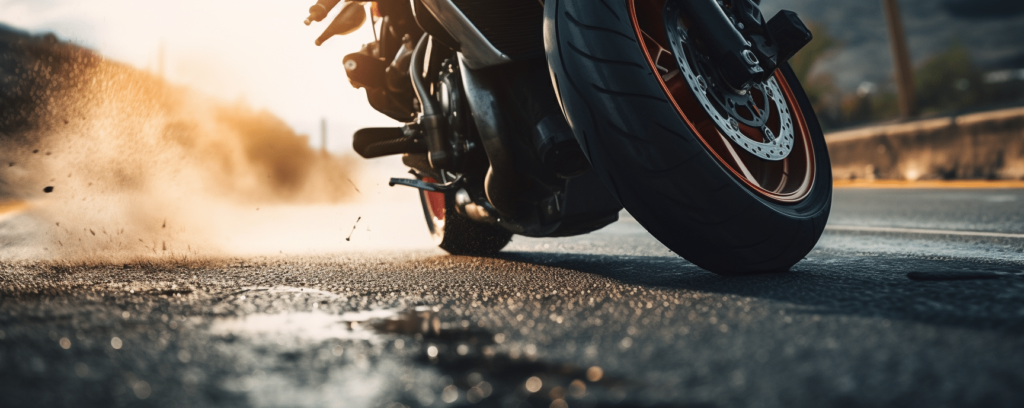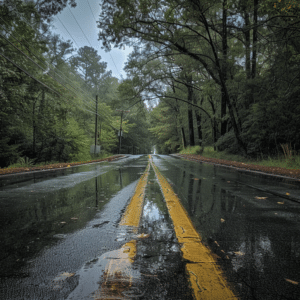How In the Event of an Emergency a Motorcycle Can Stop Safely
Last updated Wednesday, April 17th, 2024

In the event of an emergency, can a motorcycle stop quickly enough to avoid a collision? This crucial question is at the heart of rider safety. Our focused guide dives into the techniques and underlying mechanics of “in the event of an emergency a motorcycle can stop”, offering riders actionable knowledge to manage their machines with confidence and precision when every second counts.
Key Takeaways
- Effective emergency braking on a motorcycle relies on the front brake primarily, requires understanding the bike’s braking system, maintaining proper body position, and managing brake pressure to avoid skids.
- Motorcycle stopping distance is greatly affected by factors such as the rider’s experience, speed, road conditions, and the motorcycle’s maintenance, especially the brakes and tires.
- Motorcycle safety can be greatly improved with technology like ABS, which prevents wheel lock-up, and through rider training, consistent practice, and mental preparation for emergency situations.
Get Your FREE Case Review Today
Contact us today and we will help you get the compensation that you deserve.
or Send Us Your Case DetailsGet Your FREE Case Review Today
Contact us today and we will help you get the compensation that you deserve.
or Send Us Your Case DetailsEmergency Braking on a Motorcycle
When it comes to rider safety, the ability to stop swiftly and avoid potential accidents is paramount. Emergency braking on a motorcycle involves a progressive squeeze of the brake levers, with a greater focus on the front brake. This is because the front brake contributes significantly more to a motorcycle’s stopping power than the rear brake. It may seem counterintuitive, but using the front brake correctly can drastically reduce stopping distances and prevent accidents.
However, proper emergency braking requires more than just squeezing the brake lever. It’s a combination of:
- Understanding your bike’s braking system
- Maintaining proper body position
- Managing brake pressure effectively
- Adapting to various road conditions and speeds
Let’s delve deeper into these components.
Understanding the Braking System
At the heart of a motorcycle’s stopping power is its braking system. This system uses hydraulics to transfer the force from the lever to the brake pads against the disc, effectively slowing down and eventually stopping the bike. The efficiency of this system relies on utilizing non-expanding brake lines and a fluid that does not compress, while also ensuring there are no leaks in the system.
Force amplification within the braking system is achieved through the interplay of a master cylinder at the lever and larger pistons in the calipers. Different caliper designs, such as radial or monoblock configurations, are employed to either increase stiffness or reduce flex within the braking mechanism. Understanding these components and how they work together can significantly enhance your stopping power and overall safety on the road.
Proper Body Positioning
When it comes to emergency braking, your body positioning plays a critical role in ensuring stability and control. As you apply the brakes, weight is transferred to the front tire, which increases its grip due to the compression of the forks and an enlarged contact patch. This weight transfer is essential for maintaining control and ensuring a safe stop.
Maintaining a correct body posture during emergency braking means:
- Keeping your body relaxed
- Keeping your arms slightly bent, allowing for efficient manipulation of the controls
- Having your feet firmly on the footpegs, ready to use the rear brake pedal if necessary
Remember, proper body positioning not only enhances control during emergency stops but also contributes to more comfortable and safer rides in general.
Brake Pressure Management
Effective brake pressure management is key to preventing skids and maintaining control of the motorcycle during emergency stops. The process involves:
- Applying slight pressure to the back brake
- Gradually increasing the pressure on the front brake to come to a smooth stop
- Pulling in the clutch and shifting down to first gear as you come to a stop.
The optimum braking point is just before the front wheel locks up, indicating maximum deceleration without losing traction. This point is often referred to as the “threshold” of braking, and mastering it requires practice and understanding of your bike’s braking system, including the rear wheel. Remember, abrupt or excessive pressure can lead to wheel lock-up and a potential skid, so smooth, progressive pressure is key.
Factors Affecting Motorcycle Stopping Distance

- Rider experience
- Fatigue
- Road conditions
- The state of your motorcycle
By considering these factors, you can ensure that you are able to stop your motorcycle safely and efficiently.
For instance, riders with more experience can stop more effectively because they are likely to have a better reaction time and higher skill level in modulating the brake strength. Fatigue can significantly impair your ability to focus and react quickly, leading to longer stopping distances. Additionally, road conditions can greatly affect your stopping distance. Some factors to consider include:
- Wet or slippery surfaces, which can nearly double your stopping distance compared to dry conditions
- Uneven or gravelly surfaces, which can cause your tires to lose traction and increase stopping distance
- Obstacles in the road, such as potholes or debris, which can require sudden braking and increase stopping distance
It’s important to be aware of these factors and adjust your riding accordingly to ensure safe stopping distances.
Let’s delve deeper into these factors to find the answer.
Speed
One of the most critical factors affecting stopping distance is speed. The faster you’re going, the longer it will take you to stop. This is because the additional momentum that comes with increased speed needs to be overcome when braking.
While it might be tempting to push the limits of your machine, it’s crucial to remember that the consequences can be severe. A slight increase in speed can result in a significant increase in stopping distance, reinforcing the importance of maintaining a safe speed, particularly in busy traffic or adverse weather conditions. Remember, the faster you go, the less time you have to react to unexpected situations.
Road Conditions
The condition of the road you’re riding on is another vital factor influencing your stopping distance. Wet or slippery surfaces significantly decrease tire traction, leading to increased stopping distances and a higher risk of losing control. Even potholes and uneven road surfaces can disrupt the contact between your motorcycle tires and the road, leading to sudden jolts, instability, and affecting your ability to brake effectively.
To ensure optimal grip and stopping performance, especially on challenging road surfaces, here are some tips to follow:
- Regularly check your tire tread depth and ensure it meets the recommended levels.
- Properly inflate your tires to the recommended pressure.
- Adapt your riding style and speed to the road conditions to enhance your safety and control on the motorcycle.
Motorcycle Maintenance
The state of your bike also plays a crucial role in how effectively you can stop. Regular maintenance of your motorcycle’s braking system, including the inspection of brake pads, fluid lines, and discs, is essential for achieving maximum stopping capability and ensuring prompt, safe stops.
Tires, too, are a critical safety feature. Regular checks for adequate tread depth, correct inflation, and overall wear contribute to optimal stopping performance. Additionally, correctly set and periodically serviced suspension components, such as forks and shocks, are vital to maintaining the motorcycle’s handling capabilities and braking performance. Remember, a well-maintained bike not only rides better but is also safer.
The Role of Anti-Lock Braking Systems (ABS)
In the realm of motorcycle safety, technology has brought us the anti lock braking system (ABS). These systems help prevent wheel lock-up and increase stability, especially since motorcycles are inherently less stable than four-wheeled vehicles. ABS minimizes the chances of wheel lock-up during intense braking situations, particularly on slippery surfaces.
ABS’s role in enhancing rider safety is significant. In many situations, motorcycles equipped with ABS have been found to reduce braking distances. A report even revealed that ABS could decrease the rate of fatalities and severe injuries from motorcycle crashes by 31%. By 2025, the adoption of ABS in motorcycles has the potential to save an estimated 22 lives, a number that could increase if ABS becomes standard on all new motorcycles.
How ABS Works
So, how does ABS work? The system uses speed sensors on both wheels to constantly monitor wheel speed. When it detects that a wheel is about to lock, it triggers mechanisms that modulate braking pressure. This adjustment allows the rider to maintain better control during an emergency stop, thus preventing potential accidents.
ABS is designed to intervene only when necessary, allowing riders to brake as they normally would in most situations. It’s like having a safety net that kicks in only when you’re on the verge of losing control, providing you with an extra layer of protection when you need it the most.
ABS vs. Non-ABS Motorcycles
Motorcycles with ABS can maintain better traction during braking, potentially leading to shorter stopping distances compared to non-ABS models. Despite the clear benefits, as of 2015, only about 20% of new motorcycles came with ABS as a standard feature.
While ABS can significantly enhance safety, it’s not a substitute for good braking techniques and safe riding habits. It’s an additional tool in your safety kit, working alongside your skills to keep you safer on the road. Whether you’re riding a motorcycle with ABS or not, understanding your bike’s braking system, practicing safe braking techniques, and maintaining your bike in good condition are all crucial for safe riding.
Evasive Maneuvers and Emergency Situations
Sometimes, stopping isn’t the best option. In certain situations, evasive maneuvers may be a safer choice than emergency braking. These maneuvers, such as swerving or negotiating around an obstacle rather than coming to a sudden stop, require a strong sense of balance and fast reflexes to maneuver the motorcycle swiftly and safely.
Techniques like swerving, lane splitting, and recognizing potential escape routes play a crucial role in emergent situations. These maneuvers can be life-saving when executed correctly, allowing you to avoid potential accidents by swiftly steering around obstacles instead of attempting to stop abruptly.
Swerving
Swerving is a technique that involves quickly changing direction to avoid a hazard. It’s a controlled, two-part maneuver: one swift steering input to change direction, and another to return to your original path. It’s crucial to remember not to brake during a swerve, as this can lead to a loss of control.
While it may seem daunting, swerving is a skill that can be mastered with practice. Safety courses often include focused practice on swerving, helping riders to develop the quick reflexes and precise control needed to execute this maneuver safely. Remember, the goal of swerving is to avoid a collision, not to maintain your original speed or direction.
Lane Splitting
Lane splitting, the practice of riding between lanes of slow or stopped traffic, is another evasive maneuver that can help motorcyclists avoid rear-end collisions. This practice is legally accepted in some states, with California being the only state where it is explicitly legal.
While lane splitting can improve visibility, reduce rider exposure to congestion, lower fuel consumption, and decrease overall traffic congestion, it requires high levels of skill and attention. It’s crucial to be aware of other road users who may not expect a motorcycle to be passing between lanes and to always prioritize safety over speed.
Escape Routes
Being constantly aware of your surroundings and having predetermined escape routes can be life-saving by enabling swift and effective reactions to emergencies. This is part of what riders call ‘situational awareness’ – constantly scanning your environment for potential hazards and escape paths, ultimately leading to a safe location.
Consider this: if a car suddenly stops in front of you, do you have enough space to stop? If not, is there a clear path you can safely swerve into? Having these escape routes in mind as you ride can make the difference between a near-miss and a collision, especially in heavy traffic with cars or at high speeds.
Motorcycle Rider Training and Preparedness
The skills needed to handle a motorcycle safely in various situations don’t just come naturally. They are developed and honed through motorcycle safety training, regular practice, and mental readiness. Rider education plays a crucial role in enhancing a motorcyclist’s skills to effectively manage emergency situations encountered on the road.
Through safety training, riders learn to recognize and appropriately react to potential hazards. This can be the difference between a safe stop and an accident. But it’s not just about formal training courses. Regular practice and mental preparation are also essential to becoming a proficient and safe rider.
Riding Courses
Motorcycle safety courses are designed to teach riders proper braking techniques and how to safely execute evasive maneuvers. These courses vary in level, ranging from beginner to advanced, ensuring that riders can find training that matches their experience level.
A standard element of these courses includes a skill test which covers a range of maneuvers, from basic swerves to managing low-speed weaves. These skills are crucial for handling emergency situations on the road.
Remember, riding a motorcycle safely is about more than just controlling the machine – it’s about being prepared for whatever the road throws at you.
Regular Practice
While formal training provides the foundation for safe riding, regular practice helps to maintain and refine these skills. Consistent practice is crucial for maintaining the skills necessary for effective emergency braking on a motorcycle.
Practicing difficult motorcycle riding skills in a safe environment, such as an empty parking lot, can help riders prepare for avoiding collisions in real-world scenarios. Additionally, practicing emergency stops during regular rides can help motorcyclists improve their reflex responses and increase the likelihood of successfully executing an emergency stop when needed.
Mental Readiness
Riding a motorcycle safely requires not just physical skill, but also mental readiness. Distractions and emotional turbulence can significantly impair a rider’s focus and situational awareness, affecting their ability to react effectively in emergency situations.
Pre-ride mental preparation techniques such as deep breathing and visualization can help riders enhance their focus and awareness. In crisis situations, approximately one-third of motorcycle riders fail to apply the brakes due to panic, a response that can be mitigated with proper safety training.
Safety training not only enhances skills but also contributes to self-confidence and enjoyment in riding, aiding in better mental preparedness for emergency situations.
Frequently Asked Questions
How quickly can a motorcycle stop?
On average, a motorcycle traveling at 60 mph can come to a complete stop in about 129 feet, about 6 feet sooner than a car traveling at the same speed. At the maximum braking capability for most motorcyclists (1 G), a motorcycle at 45 mph can stop within 67 feet.
Can motorcycles brake more slowly than autos?
Yes, motorcycles can brake more slowly than cars, requiring approximately 18 percent more space to stop. Therefore, it’s important for motorcyclists to maintain a safe following distance.
What is the average stopping distance for a motorcycle?
The average stopping distance for a motorcycle is typically around 120 – 140 feet, based on road tests of current production motorcycles. So, it is important to consider this when riding and braking.
How to do an emergency brake on a motorcycle?
To perform an emergency brake on a motorcycle, you should roll off the throttle, squeeze in the clutch, and use a smooth, progressive squeeze on the front brake to stop the motorcycle effectively. Apply the rear brake a fraction of a second later and keep both brakes applied until the bike stops.
What is the most important thing to remember when performing emergency braking on a motorcycle?
When performing emergency braking on a motorcycle, remember to apply a progressive squeeze on the brake levers, focus more on the front brake, and maintain proper body position for control and stability. This will help you stop safely and maintain control of the motorcycle.






